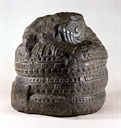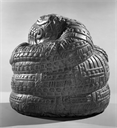Description
Snakes were important symbolic animals in ancient Mesoamerica and particularly in Aztec mythology. As such, they are represented frequently in Aztec art. While some artists created veristic snake sculptures, others produced stylized versions representing hybrid supernatural creatures. Commonly known as a Fire Serpent, this coiled snake represents a Xiuhcóatl, a mythical creature whose Nahuatl name translates as “turquoise snake.” To the Aztecs, turquoise denoted preciousness and was related to time, the calendar, fire, and celestial bodies. Fire Serpents carried the sun on its journey across the sky, bringing light to the world each day. They were also associated with several Aztec gods, including Huitzilopochtli, who carried a Fire Serpent as a weapon, and Xiuhtecuhtli, the fire god at the center of the world.
The head of this coiled snake is damaged and its snout is missing, but three sets of curved fangs still remain, protruding from each side of the mouth. There may once have been a bifurcated tongue or symbolic sacrificial knife extending from the mouth. Its body is segmented and two arms flank the head and terminate in menacing claws. These may allude to the thoracic legs of caterpillars, which were associated with igniting fires and shooting stars by the Aztecs. The end of the tail bears a glyph representing a year sign. The underside of this sculpture bears two glyphs. The year ‘2 Reed’ appears in a
cartouche, and the name of the ruler Motecuhzoma Xocoyotzin (502–520 CE) is indicated by a ruler’s headdress with a curl of smoke or speech. Read together, these glyphs refer to the year 1507. This was the date of a New Fire Ceremony, one of the Aztec calendar’s most important events. This event commemorated the passage of a fifty-two-year cycle, when all fires were extinguished, and sacrifices were made to ensure the beginning of a new era and a return of light and fire to the Aztec world. The snake shown here, a symbol of fire and time, may have commemorated Motecuhzoma’s patronage of the event.
Bibliography
1957. Artes de Mexico 17. pl. 3.
Alcina Franch, José, Miguel León Portilla and Eduardo Matos Moctezuma (EDS.) 1992 Azteca Mexica. Colección Encuentros. Serie Catálogos. Lunwerg Editores, Barcelona. p. 198, pl. XL.
Benson, Elizabeth P. 1963 Handbook of the Robert Woods Bliss Collection of Pre-Columbian Art. Dumbarton Oaks, Trustees for Harvard University, Washington, D.C., p. 23, cat. 107.
Bliss, Robert Woods 1947 Indigenous Art of the Americas: Collection of Robert Woods Bliss. National Gallery of Art, Smithsonian Institution, Washington, D.C., p. 23, 114-115, cat. 110.
Bliss, Robert Woods 1957 Pre-Columbian Art: The Robert Woods Bliss Collection. Text and Critical Analyses by S. K. Lothrop, Joy Mahler and William F. Foshag. Phaidon, New York. p. 242-243, cat. 56, pl. XLII, fig. 14.
Bliss, Robert Woods 1959 Pre-Columbian Art: The Robert Woods Bliss Collection. 2nd ed. Text and Critical Analyses by S. K. Lothrop, Joy Mahler and William F. Foshag. Phaidon, London. p. 250, cat. 56, pl. XLII, fig. 14.
Bühl, Gudrun (ED.) 2008 Dumbarton Oaks: The Collections. Published by Dumbarton Oaks Research Library and Collection, Washington, D.C., p. 190-1.
Christensen, Erwin Ottomar 1955 Primitive Art. Bonanza Books, New York. p. 208, 241, fig. 196.
Gutiérrez Solana, Nelly 1987 Las Serpientes En El Arte Mexica. 1a ed. Colección De Arte; 40. Universidad Nacional Autónoma de México Coordinación de Humanidades, México. p. 140, 148, pl. 83.
Hajovsky, Patrick Thomas 2007 On the Lips of Others: Moteuczoma's Fame in Aztec Monuments ans Rituals. University of Texas Press, Austin. p. 91, fig. 5.5.
Izeki, Mutsumi 2008 Conceptualization of 'Xihuitl': History, Environment and Cultural Dynamics in Postclassic Mexica Cognition. Bar International Series; 1863. Archaeopress: Available from Hadrian Books, Oxford, England. p. 44, 112, fig. 6.17.
Kubler, George 1984 Ancient American Gods and Their Living Impersonators. Apollo CXIX (266):10-20. p. 16, fig. 10, 11.
Lippincott, Kristen 1999 The Story of Time. Merrell Holberton, London. p. 90, cat. 083.
McEwan, Colin and Leonardo López Luján (EDS.) 2009 Moctezuma: Aztec Ruler. British Museum Press, London. p. 174, cat. 76.
Palacios, Enrique Juan 1935 La Cintura De Serpientes De La Piramide De Tenayuca. In Tenayuca: Estudio Arqueológico De La Piramide De Este Lugar, Hecho Por El Departamento De Monumentos De La Secretaría De Educación Pública, José Reygadas Vértiz, ed., pp. xiii, 350. Talleres Gráficos del Museo Nacional de Arqueología Historia y Etnografía, México. p. 264, fig. 15, 16.
Ries, Maurice Ruddell 1942 Ancient American Art, 500 B.C.-A.D. 1500; the Catalog of an Exhibit of the Art of the Pre-European Americas, April-June 1942, Santa Barbara Museum of Art. Santa Barbara Museum of Art, Santa Barbara. cat. 110.
Robertson, Donald 1959 Review Article. College Art Journal 19 (1). p. 106-107.
Solís Olguín, Felipe R. (ED.) 2004 The Aztec Empire: Catalogue of the Exhibition. Guggenheim Museum Publications, New York. p. 35, cat. 144.
Vila Llonch, Elisenda 2009 Moctezuma and the Aztecs. British Museum Press, London. p. 70-71.
Willey, Gordon Randolph 1966 An Introduction to American Archaeology, Vol. 1: North and Middle America. Prentice-Hall Anthropology Series. Prentice-Hall, Englewood Cliffs, NJ. p. 162, fig. 3.117.
Exhibition History
American Museum of Natural History, New York, NY, March 1941 - June 1942, November 1942 - February 1947.
"Ancient American Art", Santa Barbara Museum of Art, Santa Barbara, CA, April - June 1942; M. H. De Young Memorial Museum, San Francisco, CA, July - August 1942; Portland Museum of Art, Portland, OR, September - October 1942 (catalogue # 110).
"Indigenous Art of the Americas", National Gallery of Art, Washington DC, April 1947 to July 1962.
"Azteca Mexica, Las Culturas del Mexico Antiguo", Museo de America, Madrid, 1992.
"The Story of Time", National Maritime Museum, London, England, 12/1/1999 - 9/24/2000 p. 90, cat. no. 083.
"The Aztec Empire", Guggenheim Museum, New York, NY, 10/14/2004 - 2/13/2005; Guggenheim Museum, Bilbao, Spain 3/15/ - 9/4/2005.
"Moctezuma, Aztec Ruler", The Britism Museum, London, 9/24/2009 - 1/24/2010.

